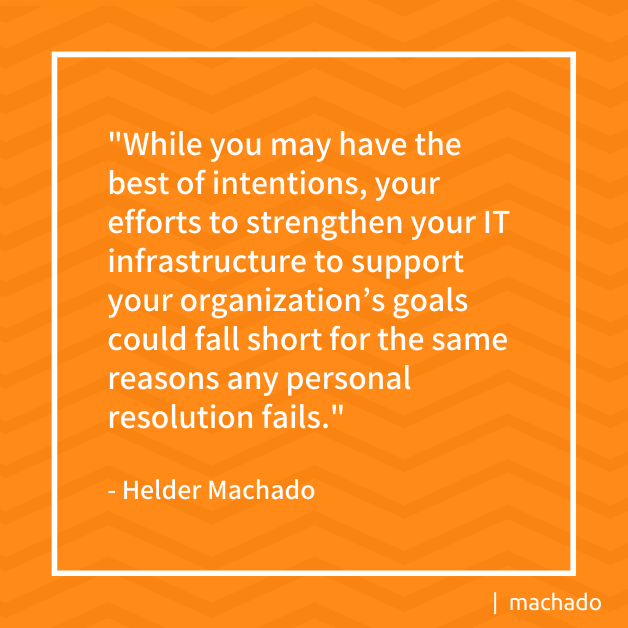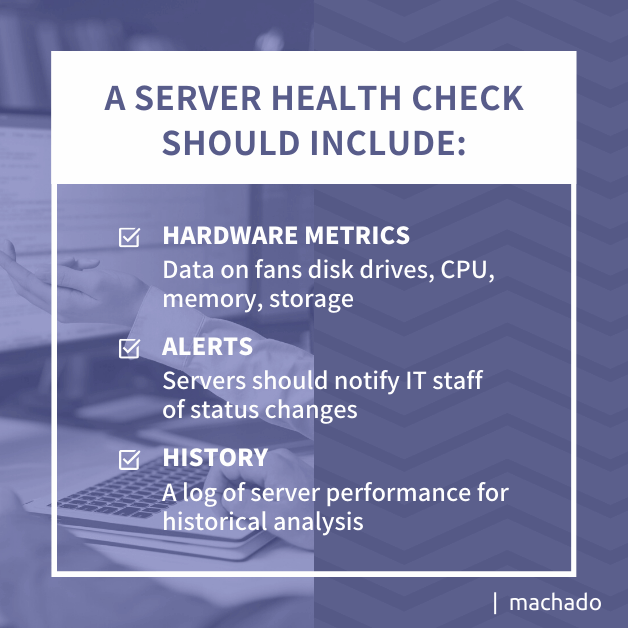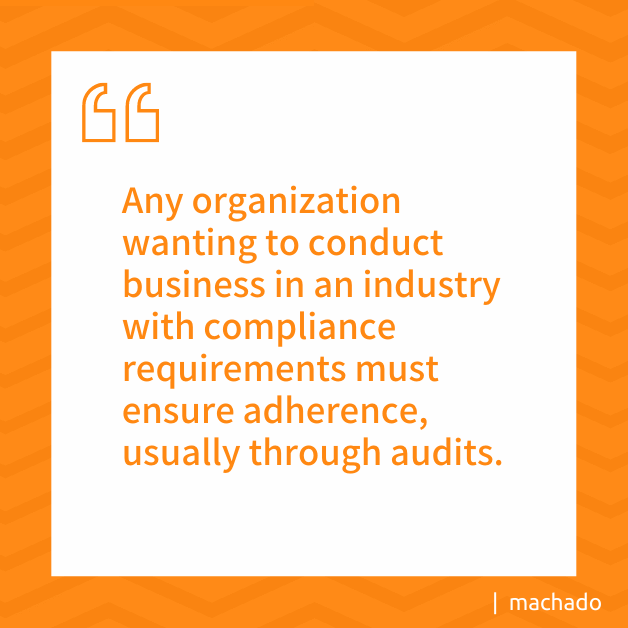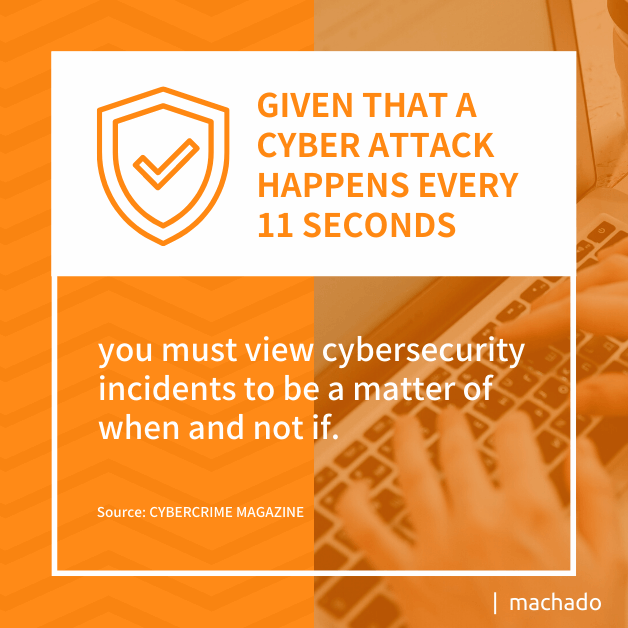A new year brings resolutions and a focus on health priorities probably tops your list. If you’re like most people, some of your resolutions might fail for any number of reasons, including a lack of commitment and trying to do things on your own. It’s no different when it comes to your professional resolutions – especially protecting the health of your IT infrastructure. A commitment to focus on your IT infrastructure monitoring activities can result in better network and server health, reduced cybersecurity threats, and even help you prepare for audits required for your industry compliance.
While you may have the best of intentions, your efforts to strengthen your IT infrastructure to support your organization’s goals could fall short for the same reasons any personal resolution fails. Some of these may feel familiar to you:
- Lack of commitment. Many organizations believe their IT environment is running just fine and don’t realize they actually are prime targets for issues like for cybersecurity attacks.
- Too ambitious. Companies try to implement multiple initiatives at the same time rather than using a phased approach that maximizes resources.
- No milestones. IT planning, especially around the creation of policies, takes time. Setting interim goals provides a positive incentive for completing a resolution.
- Lack of resources. Many businesses try to implement big IT infrastructure changes when they lack the resources for completion. Often the best, and most cost-effective, decision is to acknowledge resource limitations and look outside the company for expert assistance.
- Focus on negatives. Most businesses view requirements to avoid activities like cybersecurity threats as a series of do-nots. (Do not use weak passwords. Do not click on links, etc.) By shifting the mindset to focus on positives, companies can build a stronger IT awareness culture.

1. Server Health Checks
Server health is more than evaluating the performance of the physical server. A server health check includes analyzing performance metrics based on the server’s function. For example, performance demands for a database server are different from those of an email server. A front-facing web server requires different resources from its back-end server. Knowing the performance demands of each server type is critical to understanding server health.
What to Check?
While a physical check may include disk capacity, CPU usage, or memory availability, each server should be evaluated in relation to the entire infrastructure and its place within that structure. A server health check should deliver:
- Hardware metrics. Quantitative data on fans disk drives, CPU, memory, storage, and environmental conditions.
- Alerts. Servers should notify IT staff of status changes.
- History. Logs server performance for historical analysis.
The historical data from a server health check provides a baseline that can be used to configure alerts to flag potential cybersecurity threats.
Why Perform Server Health Checks?
Deviation from the baseline may signal unauthorized use. Early detection can reduce or eliminate the impact of cyberattacks. According to IBM’s 2021 Cost report, companies took an average of 287 days to detect and contain a breach. That is seven days longer than in 2020. The difference in cost for those taking more than 200 days was over $1 million. Those who took less than 200 days had an average cost of $3.6 million.
Monitoring server performance goes beyond optimization. It can serve as an early warning system for potential threats. By analyzing the data, staff can set alerts, so they are notified of any anomalies. After all, the faster a potential threat is detected and contained, the lower the cost.
2. IT Compliance Checks and Audits
IT compliance audits examine an organization’s infrastructure, data, applications, policies, processes, and procedures against published standards. Audits are often required to ensure compliance with government or industry standards. Depending on the industry, some companies may have multiple compliance standards to meet.
What to Include in IT Compliance Checks
What goes into an IT compliance check depends on the standards a company must adhere to. The range of compliance standards include:
- European Union General Data Protection Regulation (GDPR). These regulations stipulate that anyone from the EU may request that a company remove their personal data regardless of where the company is located. It is known as the right to be forgotten rule.
- Gramm-Leach-Bliley Act (GLBA). This US law required financial institutions to inform customers of how they may share their data and ensure that all sensitive information is secure.
- Health Insurance Portability and Accountability Act (HIPAA). These regulations require healthcare facilities and providers to protect patients’ health care information.
- Personal Information Protection and Electronic Documents Act (PIPEDA). Canadian law protects an individual’s personal and sensitive data.
- California Consumer Privacy Act (CCPA). California’s law that follows the GDPR provides its residents with the right to be forgotten.
- Sarbanes-Oxley Act. This law stipulates accounting and reporting to protect against misrepresentation of corporate finances.
- Payment Card Industry Data Security Standards (PCI-DSS). This independent standard applies to any organization that accepts credit or debit card payments.
- Service Operating Control (SOC). The American Institute of Certified Public Accounts published this standard as a guide for companies wanting to ensure their service providers were following best practices for data protection.
- Cybersecurity Maturity Model Certification (CMMC). The US Department of Defense (DoD) pieced together this model in an effort to implement one standard across the Defense Industrial Base and key US assets, infrastructure and secrets.
The list is not comprehensive, but it illustrates the increasing number of regulatory requirements that companies must address. Several states are in the process of passing legislation similar to CCPA and the federal government has created additional regulations through Executive Orders.
Why Are Compliance Checks Important?
IT compliance which often includes cybersecurity standards, such as CMMC Certification, is centered around third-party requirements. Any organization wanting to conduct business in an industry with compliance requirements must ensure adherence, usually through audits. Third-parties may include.
- Industry regulations
- Government policies
- Security frameworks
Failure to comply with the standards may have legal and financial ramifications. It can result in loss of revenue and a damaged reputation.
According to IBM’s report, 38% of financial losses due to security compromises come from lost business. Consumers lack confidence in a company that has suffered a cyberattack. They tend to avoid doing business with the company for at least a year with some never returning. The impact can extend well beyond the immediate future. Online searches may return results that include references to a prior security breach years after it occurred.
GDPR violations can result in fines up to a percentage of a company’s global revenue. In the US, PCI violations may result in fines and penalties. Individual lawsuits may be filed by those impacted by a data breach. In some instances, VISA and MasterCard may prevent companies from accessing their networks for transaction authorizations.
If you do not perform compliance checks and audits, you may fail to correct vulnerabilities that can lead to security violations. Making sure that data transmission and storage are secure and in compliance with all applicable regulations minimizes the risk of data exposure and subsequent losses.
3. Network Audits
Networks change. Many networks include the cloud, as well as on-premise deployments. Networks are more distributed as workers continue to work from home. These changes can put a company at risk if the network does not go through systematic audits.
What is a Network Audit?
Network audits assess a network’s composition through analysis of the components that make up the system. They look at security, control, availability, performance, and management. Once the data is collected, the auditors identify vulnerabilities and analyze network management and control. Network security audits focus on the following:
- Network nodes
- Network control processes
- Network security policies
- Network monitoring capabilities
They focus on network security and control to reduce attack surfaces and close vulnerabilities.
Why are Network Audits Important?
Increases in network size and complexity create inefficiencies and vulnerabilities that lead to system failures and compromises. Without regular network audits, organizations risk creating an environment that is difficult to control and hard to protect. Security audits can identify the following:
- Outdated hardware
- Unused or unauthorized software
- Software lacking updates
- Old or unnecessary user accounts
- Misconfigurations
These discoveries can result in known vulnerabilities that cybercriminals exploit to gain access to digital assets. For example, a recent attack on Microsoft’s Exchange Server exploited a known vulnerability of on-premise installations. Because many organizations did not apply updates, they were open to attack. A network security audit would have identified the lack of updated software.
4. Cybersecurity Audits
You need a clear picture of your organization’s security landscape. You need to know that your business has a strong security posture that adheres to all compliance requirements. Without a comprehensive understanding of security protocols, you can fall victim to a cyberattack. Given that a cyber attack happens every 11 seconds, you must view cybersecurity incidents to be a matter of when and not if.
What is a Cybersecurity Audit?
Security audits provide a systematic approach to evaluating an enterprise’s security. They often help you meet compliance requirements as well as identify critical weaknesses that must be addressed. Audits usually involve diagnostics, vulnerability assessments, and penetration testing. Other tools may be used to provide a comprehensive understanding of a company’s security posture.
Although cybersecurity audits can be performed using in-house staff, most compliance standards require third-party auditors. These trained professionals, like the team at Machado Consulting, present an objective assessment of security, minimizing friction that may occur among internal staff.
Why are Cybersecurity Audits Important?
You can’t fix a problem that you don’t know exists. Cybersecurity audits help companies identify potential weaknesses, so they are addressed before an attack occurs. In the last year, the number of data compromising incidents increased by 27%, meaning cybercriminals were more successful in their efforts to steal data. That’s why a cybersecurity health check is so crucial. Cybersecurity audits help organizations:
- Identify problems, gaps, and weaknesses in security protocols
- Create a baseline for ongoing auditing
- Ensure regulatory compliance
- Determine if security training is needed
- Eliminate unnecessary policies and processes
Audits provide a comprehensive analysis of a company’s security posture, highlighting vulnerability risks, and threats that impact operations. Security audits look at data and operational processes as well as network and system protocols. It can include physical security assessments to ensure restricted access to critical facilities.
5. Backups and Disaster Recovery Checks
For many organizations, disaster recovery and backup systems operate on a one-and-done strategy. The system is exercised when created and is never tested until a disaster occurs. Learning that a backup system isn’t working in the middle of a catastrophic event is too late. You need to ensure your business is not part of the 40% that only tests once a year or in 25% of the cases – never. Backup checks should be a regular part of your IT infrastructure monitoring and occur any time there is a change in your network landscape.
What is Disaster Recovery?
Although disaster recovery plans encompass more than system backups, an offsite copy of a company’s network is critical to any disaster recovery plan. Disaster recovery is an organization’s plan for regaining control of its IT infrastructure after a natural or man-made disaster. Whether it is a power failure or a catastrophic event such as a hurricane, companies need to restore operations as quickly as possible. That effort requires a copy of production data or backups.
Why are Backup Checks Important?
For disaster recovery plans to work, they need an up-to-date copy of production data. As networks grow, new data stores may develop or configuration changes may block data from being backed up. These changes mean that disaster recovery plans will fail because the backups are incomplete.
To prevent such failures, disaster recovery and backup checks should occur when there’s a system upgrade or data migration. If changes are required to address compliance laws, backups should be checked to ensure they are working properly. Having scheduled health checks makes it easier to determine if data is being replicated as planned.
Achieving Your IT Infrastructure Resolutions
To achieve your IT Infrastructure resolutions, the five priorities outlined here should help you begin to build a well-developed IT infrastructure monitoring plan. And don’t forget, sometimes expert guidance can help you to achieve your most challenging resolutions. The team at Machado Consulting can provide you by providing a comprehensive picture of your current IT health status. In fact, we’d like to offer a FREE Network Health Check to show you where your vulnerabilities are hiding. Our health checks and audits can help you to closely examine your network, server health, cybersecurity protection, and more. Together, we can help you achieve your professional resolutions.







